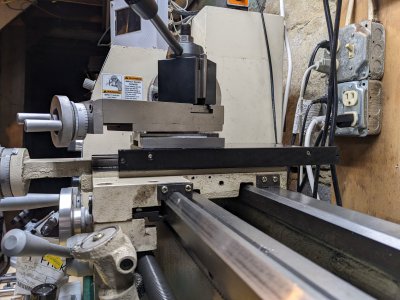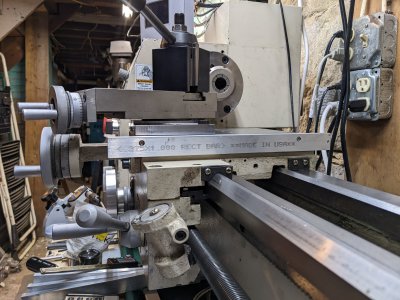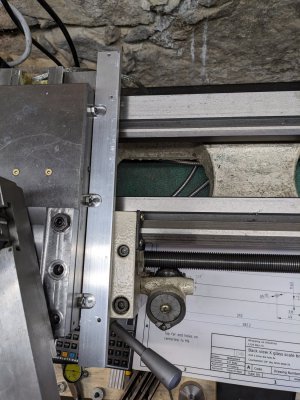- Joined
- Dec 18, 2019
- Messages
- 6,468
My prop spacer for the X-scale came out ok. It was slightly undersized, but only by a 1/2 mm (over 286mm) so I call that a victory. It fit pretty well, the PETG piece was screwed to the mounted cross slide (2 M3 screws) and confirmed the basic operation was ok, the travel made sense and the offset was sensible. The piece itself isn't very stiff, I printed it with 3 perimeters, in draft mode, and only 20% infill, but it is serving it's purpose.
I installed the uncut glass scale on one end of the PETG piece, with an M4 screw, and made sure everything was below the cross slide, and then marked the other end of the scale for cutting. I think I will leave one end of the aluminum a mm or two longer, in case the cutting of the scale goes awry with total length.
You don't have any pictures right now, because 1) I forgot to bring my phone down to the shop, and 2) black PETG prints are tough to photograph well. Should have printed it in red...
What's next? Need to cut the aluminum to the basic shape, 3/8" x 23.25mm x 290mm for now. I don't see a need to change the 3/8" dimension, it's good enough. Then machine it.
Then I need to figure out how to clamp the scale and cut it. I'll try the mill first to see if it fits. Otherwise I will have to use cruder ways.
If I'm too intimidated by the scale cutting, then I'll work on extending the back splash. Have to do that anyways. Then back to the scale trimming.
Still need to make a spacer for the read head. Think I may mill the lower half of the cross slide flat. Right now there's an annoying 4 degree (or so) angle to it. Once the lower cross slide is in the mill, then I can also drill and tap the mounting holes.
I installed the uncut glass scale on one end of the PETG piece, with an M4 screw, and made sure everything was below the cross slide, and then marked the other end of the scale for cutting. I think I will leave one end of the aluminum a mm or two longer, in case the cutting of the scale goes awry with total length.
You don't have any pictures right now, because 1) I forgot to bring my phone down to the shop, and 2) black PETG prints are tough to photograph well. Should have printed it in red...
What's next? Need to cut the aluminum to the basic shape, 3/8" x 23.25mm x 290mm for now. I don't see a need to change the 3/8" dimension, it's good enough. Then machine it.
Then I need to figure out how to clamp the scale and cut it. I'll try the mill first to see if it fits. Otherwise I will have to use cruder ways.
If I'm too intimidated by the scale cutting, then I'll work on extending the back splash. Have to do that anyways. Then back to the scale trimming.
Still need to make a spacer for the read head. Think I may mill the lower half of the cross slide flat. Right now there's an annoying 4 degree (or so) angle to it. Once the lower cross slide is in the mill, then I can also drill and tap the mounting holes.




